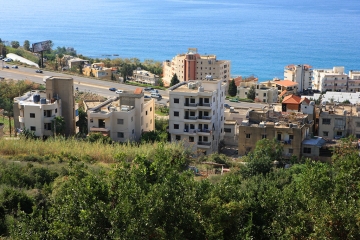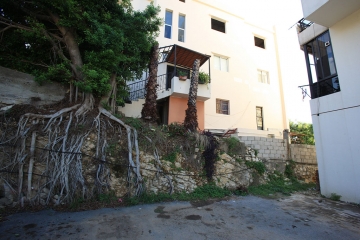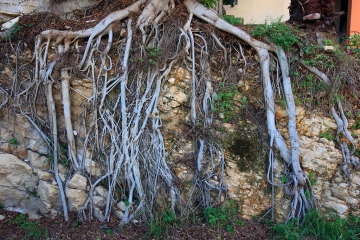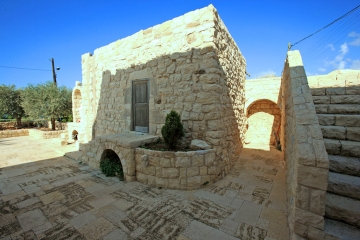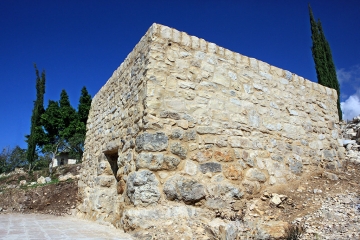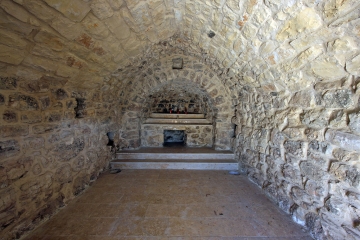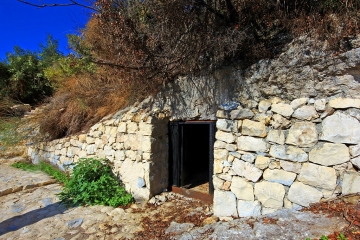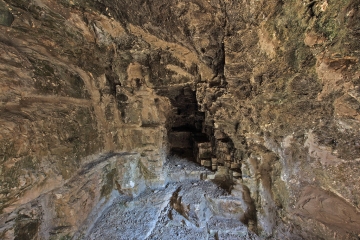دير السيّدة - حالات
يُمكن اللاستنتاج، من الاطّلاع على الوثائق والكتابات التاريخية المُتعلقة بدير السيّدة في بلدة حالات، التي تَعني جِراراً وأواني خزفية، أنَّ اختياره مقراً بطريركياً مارونياً لمُدةٍ من الزمن يَعود الى التنافُس بين فريقين من الإكليروس والشعب الماروني، أحدهما يَمحُض ولاءه للفرنجة وللكرسيّ الباباوي في روما، والثاني يتحَفَظ على الانجراف المُطلق في التبعية للغرب، تَحفُّظاً ناشئاً عن استيائه من تصرُّفات الصليبيين تجاه أهل البلاد وسوء مُعاملتهم لهم، ومُحاولتهم الاستئثار بالسُلطة على الكنائس الشرقية وإحلال "الليتنة" مَحل طابعها القوميّ المَحلّيّ.
وهكذا شَهِدَ العام 1282 وجود بطريركين معاً نتيجة هذا الانقسام الخطير بين الموارنة، ولم ينتهِ هذا الانقسام إلاّ على أثر حملة المماليك على جبة بشرّي واعتقال البطريرك دانيال الحدشيتي (1278-1282) واستشهاده، وانكفاء (أو اختفاء) البطريرك لوقا البنهراني، وبعد المساعي التي بذلها البطريرك اللاتيني إمريك.
فمؤلِّف كتاب "حالات" الأستاذ جلال شربل يَذكُر في كتابه هذا أنه "عندما فَرَغَ الكرسيّ البطريركي بوفاة البطريرك الحدشيتي، تَدخَّل الفَرَنج ونَصَّبوا إرميا الدملصاوي (1282-1297) وأرسلوه الى روما للتثبيت.. ثم عاد واستقرَّ في دير حالات المقدَّس، ومِن المُرجَّح انه استقرَّ في دير حالات ليكون قريباً من امراء الفرنج في جبيل لحمايته".
ويتابع الكاتب: "رأى أمير جبيل أن يَنعَقِد إجتماع الآساقفة والكهنة والرهبان وأعيان الأمة في جبيل، فإنتخب المُجتمعون إرميا الدملصاوي في دير حالات المقدَّس".
كُلّ هذا تمَّ بإيعاز من أمير جبيل الصليبي. وإذا كان الكاتب يَستدرِك بقوله: " ولكنَّ المُرجَّح أن الرؤساء (رجال الدين الموارنة) اختاروا دير حالات لبُعده عن المماليك في طرابلس، وعن الجواسيس إذا ما وُجدوا في جبيل، فإن هذا يؤكد ما ذهبنا إليه، لأنه يتضح أن أمير جبيل كان وراء كل ذلك، وإن البطريرك اختار لسَكنه ديراً قريباً من أمراء الفرنج في جبيل لحمايته".
والبطريرك إرميا نفسه إعترف صراحةً، في ما كتبه بخط يده على هامش نَسخَة من إنجيل رابولا، بأن إعتلاءه السِدَّة البطريركية كان بعملٍ من أمير جبيل.. إذ قال:" طَلبَني أمير جبيل والأساقفة ورؤساء الكنائس والكهنة وألقوا قرعةً، فأصابتني وصيَّروني بطريركاً ثم أرسلوني الى روما".
فهم "صَيَّروه" بطريركاً ولم يُنتخب إنتخاباً، بل جاء بنتيجة قرعة لا تترك الأجواء التي جَرى فيها ذلك مجالاً للشَك بأن هذه القرعة قد أُحكم أمرها لكي تصيبه.
وفي ما خَصَّ دير حالات الذي سَكنه البطريرك إرميا الدملصاوي (1282-1297) فإنه كان من جملة الأديار البطريركية المارونية، ويقول عنه الدكتور كمال الصليبي:" آثاره ما تزال موجودة حتى الآن قرب كنيسة السيّدة في مزرعة الدوير" (إحدى مزارع حالات).
غير ان صاحب كتاب "حالات"، جلال شربل، يقول في كتابه :" ثمة مَن يقول بمقرٍّ بطريركيّ آخر في حالات غير دير السيّدة"، ناقلاً هذا الكلام عن لِسان أحد ابناء القرية الذي روى له أنه "في حيّ الناموس، الذي تَمرُّ فيه الطريق القديمة المعروفة بـ "درب الطاحون"، كانت توجَد كنيسة صغيرة تقوم على جزء من جدار قصر البعلبكية، وعند القيام بعملية بناء حديقة عُثر على بقايا الجدران وعليها رموز مسيحية كانت مُستعَمَلة في أوآئل عهد المسيحية". ويَستدرِك المؤلف بأنه، هو، لم يجِد شيئاً مكتوباً يلقي ضوءاً على هذا الموضوع، فاعتبر الخبر غير صحيح، لكنه عاد فسمعه من أناس كثيرين من خارج حالات، فإذا صَحَّ ذلك يكون هذا المقرّ مخبأ من المخابىء التي اعتمدها البطاركة والأساقفة هرباً من الاضطهاد. وفي حالات مخابىء أخرى استُعملت لهذا الغرض، مِثلَ المغارة الموجودة عند أسفل كنيسة مار يوحنا القديمة، في ناحية زِلحمَيّا، أو في الكفور، وغيرهما، مُضيفاً عن لسان أحد المُعمّرين في بلدته إن المقَرَّ البطريركيّ كان في منطقة الناموس، وإن مقرَّ الدوير كان مدرسة تابعة للبطريركية. وقد كَشَفت عملية البناء عن مَمَرّات أرضية ودهاليز وأقبية قائمة على أنقاض أبنية قديمة بَعضُها فينيقيّ، وقد استُعمل أحد هذه الأبنية مقَرّاً بطريركياً. كما توجَد في الحيّ آثار جِرار فخّارية ونواويس حَجَرية، وكذلك مغاور كبيرة بعضها يَمتدّ مسافة عشرات الأمتار شرقاً بإتجاه حيٍّ يُدعى حيّ الغمق.
وينهي المؤلف حديثه عن دير (أو ديرَي) حالات بقوله: " لقد استمرَّ المقرُّ البطريركيّ المارونيّ في حالات خمس عشرة سنة على الأقل، وكان البطريرك يُشرِف منه على إدارة شؤون الإمارة "، موضحاً إنها إمارة لأن البطريرك كان الرئيس الديني والزمني للموارنة، أمّا المُقدَّمون فهُم موظفوه ونوابه العسكريون في المناطق.
واليوم فإن هذه المنطقة غَدَت مُجمَّعات سكنية.. خِلافاً للطابع القديم للمدرسة البطريركية القائمة بجانب كنيسة السيّدة، ومار يوحنا، اللذين ما زالا قائمَين ليومنا هذا بصورة جيّدة.
The Monastery of Our Lady of Halat
Historical writings and documents indicate that the monastery of Our Lady of Halat, a word that means earthenware pots, was designated as the Maronite Patriarchate at a certain point as the result of a competition between two ecclesiastic and popular Maronite groups, one of them loyal to the western world and to the Pope in Rome, and the other reluctant to completely commit to the west.
The dissatisfaction of the latter stemmed from the behavior of the Crusaders towards the people of the country and their mistreatment of them, and their attempt to monopolize power over the Eastern Churches and to replace the local national character with “Latinization”. This dangerous schism between Maronites lead to the existence of two patriarchs in 1282, and it only ended after the Mamluk attack on Becharreh and the arrest of Patriarch Daniel Hadshiti (1278-1282) and his death, and the disappearance of Patriarch Lucas Banharani and the endeavors of the Latin Patriarch Emeric.
Professor Jalal Charbel mentions in his book “Halat” that “After the vacuum created by the death of Patriarch Hadashiti, the Franks intervened and installed Jeremiah al-Dimlsawi (1282-1297) on the patriarchal seat and sent him to Rome for confirmation. He then returned and settled in the holy monastery of Halat, and it is likely that he made this choice of residence to remain close to the Frankish princes in Byblos who would be able to protect him.”
The author adds: “The Emir of Byblos decided that the meeting of the bishops, priests, monks, and notables of the nation should be held in Byblos, and Jeremiah Al-Damlsawi was selected to head the Holy Halat Monastery.” All this was done at the behest of the Crusader Emir of Byblos. The writer continues: “It is likely that the chiefs (the Maronite clergy) chose the monastery of Halat to avoid the proximity of the Mamluks in Tripoli, and that of any spies, should they be found in Byblos. It was clear that the Emir of Byblos was behind this decision, and that The Patriarch chose to live in a monastery close to the princes of the Franks in Byblos to remain under their protection.”
Patriarch Jeremiah himself frankly admitted, in handwritten notes on the pages of a copy of the Gospel of Rabula, that he owed his ascension to the patriarchal seat to the Emir of Byblos. He wrote: “The Emir of Byblos, the bishops, the heads of the churches, and the priests drew my name out of a lot and then sent me to Rome.” They had “made him” a patriarch, and he was not elected. Rather, his name had been drawn out of a lot. The atmosphere in which this took place leaves no room for any doubt that the whole process had been rigged in order to select him.
The monastery of Halat, which was inhabited by Patriarch Jeremiah Al-Damlsawi (1282-1297), was among the Maronite patriarchal monasteries, and Dr. Kamal Al-Salibi writes about it: “Its traces still exist today near the Church of Our Lady in Mazraat Al-Duwayr” (one of Halat farms). However, the author of the book “Halat”, Jalal Charbel, writes in his book: “It is said that the monastery of Our Lady is not the only patriarchal headquarters in Halat,” quoting one of the villagers who told him that “in the Namous neighborhood, through which the old road known as “Darb al-Tahoun” passes, there was a small church built on a part of the wall of the Baalbekiya Palace, and that, while a garden was being dug, the remains of the walls of that church were found, bearing Christian symbols that were used in the early Christian era.” He adds that he himself hasn’t found any written document that would shed a light on this matter. He initially doubted the veracity of the information, but as he heard it again from many people from outside Halat, and if it were to be true, these headquarters would have been one of the hideouts adopted by the patriarchs and bishops to escape persecution. There were also other hideouts in Halat, such as the cave located below the old Church of St. John, in the district of Zalhamia, or in Kfour, adding, citing the elder of the town, that the patriarchal headquarters was in the area of Al-Namoos, and that the headquarters of Al-Duweir was a school belonging to the Patriarchate. The construction process revealed ground corridors, labyrinths, and cellars based on the ruins of ancient buildings, some of which are Phoenician. One of these buildings was used as a patriarchal residence. There are also traces of pottery jars and stone sarcophagi, as well as large caves, some of which extend tens of meters to the east towards a neighborhood called Hay al-Ghamq.
The author concludes his writing about the monastery (or monasteries) of Halat by stating: “Halat served as the Maronite patriarchal headquarters for at least fifteen years, and the patriarch supervised the administration of the emirate’s affairs out of it,” explaining that it was an emirate because the patriarch was the religious and temporal head of the Maronites and his subordinates were his employees and military representatives in the surrounding regions. Today, this area has become an area of residential complexes, and does not abide by the old character of the patriarchal school, which is located next to the Churches of Our Lady and the Church of St. John, which are still standing and in good shape to this day..
